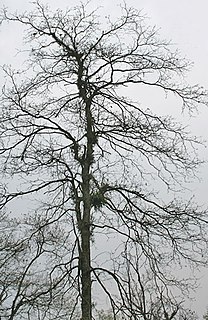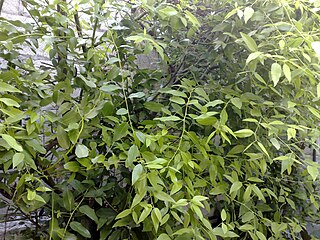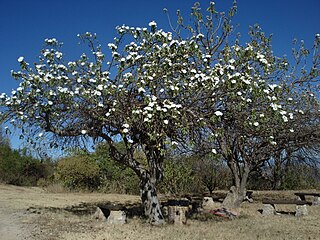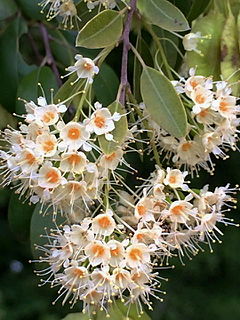
Aristotelia serrata, commonly known as wineberry or in the Māori language makomako or just mako, is a small tree in the family Elaeocarpaceae, in the genus Aristotelia, found in the North Island, South Island and Stewart Island of New Zealand.

Fagus orientalis, commonly known as the Oriental beech, is a deciduous tree in the beech family Fagaceae. It is native to Eurasia, in Eastern Europe and Western Asia.

Anogeissus is a genus of trees in the family Combretaceae. The 10 to 12 species are distributed in Asia and tropical Africa. Plants of the World Online now refers to this genus as a synonym of TerminaliaL.

Eucalyptus microcorys, commonly known as tallowwood, is a species of medium to tall tree that is endemic to eastern Australia. It has rough, fibrous or string bark on the trunk and branches, lance-shaped to egg-shaped adult leaves, flower buds in groups of seven or nine, white to lemon-yellow flowers and conical fruit. It grows in forests near the coast of Queensland and New South Wales.

Ulmus bergmannianaC.K.Schneid., commonly known as Bergmann's elm, is a deciduous tree found across much of China in forests at elevations of 1500–3000 m.

Terminalia chebula, commonly known as black- or chebulic myrobalan, is a species of Terminalia, native to South Asia from India and Nepal east to southwest China (Yunnan), and south to Sri Lanka, Malaysia, and Vietnam.
Terminalia schimperiana is a species of Terminalia, native to tropical Africa from Guinea and Sierra Leone east to Uganda and Ethiopia.

Ravensara is a genus of trees and shrubs of the family Lauraceae and endemic to the island of Madagascar and the Comoro Islands. The bark, leaves and fruit of the various species are rich in aromatic essential oils. In a recent generic classification of Lauraceae based on DNA sequence data by Chanderbali et al. in 2001, it was found to be part of a strongly supported clade that also includes Beilschmiedia, Potameia, Cryptocarya, Endiandra and Aspidostemon.
Zanthoxylum parvum, known as Shinners' tickletongue and small prickly-ash, is a species of shrub in the family Rutaceae. It is native to the mountains of Trans-Pecos Texas in Brewster and Jeff Davis counties. Zanthoxylum parvum is a rare and poorly understood plant. It is sometimes considered a synonym of Zanthoxylum americanum.

Litsea glaucescens, also called Mexican bay leaf, is an evergreen tree or shrub 3–6 metres (9.8–19.7 ft) high in the genus Litsea belonging to family Lauraceae. It is native from southern North America, mostly in Mexico. Distributed by Mexico and Central America.
Dodecadenia is a botanical genus of flowering plants of the family Lauraceae. It is present from central Asia, to Himalayas and India. It is present in tropical and subtropical montane rainforest, laurel forest, in the Weed-tree forests in valleys, mixed forests of coniferous and deciduous broad-leaved trees, Tsuga forests; 2,000–2,600 metres (6,600–8,500 ft) in China in provinces of Sichuan, Xizang, Yunnan, and countries of Bhutan, India, Myanmar, and Nepal.

Ipomoea arborescens, the tree morning glory, is a flowering plant coming from the family Convolvulaceae. It grows fast and produces semi succulent stems. This tropical plant is mostly found in Mexico. It flowers in late autumn and winter. Its common name in Nahuatl is Cazahuatl or Cazahuate.
Ribes sanchezii is a species of currant, named after Peruvian botanist Isidoro Sánchez Vega of Cajamarca. This species of Ribes is distinct form both R. andicola and R. colandina because of its ovate to elliptical leaves with a very poorly developed lateral lobe and its aberrant indument. The two latter species have leaves with pubescence on both the adaxial and abaxial surface and the adaxial leaf surface is matt green, whereas R. sanchezii has a shiny dark green upper leaf surface and pubescence abaxially restricted to the primary and secondary veins. Ribes sanchezii also has strongly resupinate fruits, whereas the fruits of R. andicola and R. colandina are pendulous.

Pteleopsis myrtifolia is one of some 10 African species in this genus in the family of Combretaceae. It is the only Pteleopsis species to occur in Southern Africa. Its flowers are strongly scented and perceived by humans to be either 'honey-like' or 'cloying' or even 'stinky'. The timber is red, hard and durable, and used for furniture and construction.

Eucalyptus microneura, commonly known as Gilbert River box, is a species of small to medium-sized tree that is endemic to Queensland. It has rough, fibrous or flaky bark on the trunk and branches, lance-shaped adult leaves, flowers in groups of seven on a branching peduncle, white flowers and conical fruit.
Quercus chrysocalyx is the accepted name of a tree species in the Asian sub-genus of 'ring-cupped oaks' and the family Fagaceae; there are no known subspecies. It is native to Cambodia, China (Yunnan), Laos, Thailand, and Vietnam.
Terminalia arostrata, commonly known as crocodile tree or nutwood, is a tree of the family Combretaceae native to northern parts of Australia.
Terminalia canescens, commonly known as joolal or winged nut tree, is a tree of the family Combretaceae native to northern parts of Australia.
Terminalia grandiflora, commonly known as yalu, plumwood or nutwood, is a tree of the family Combretaceae native to northern Australia. The Nungali and Jaru peoples know the tree as badgari and the Wagiman know it as barnyin.

Hibiscus mesnyi is a deciduous, riverine, tropical forest tree, endemic to Vietnam, in the family Malvaceae.












